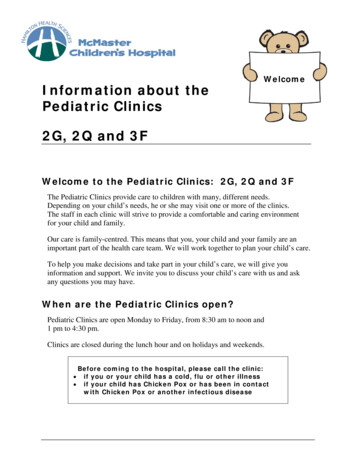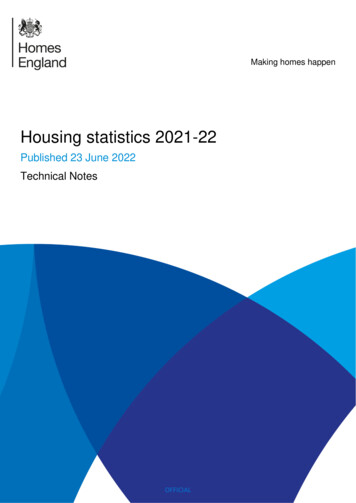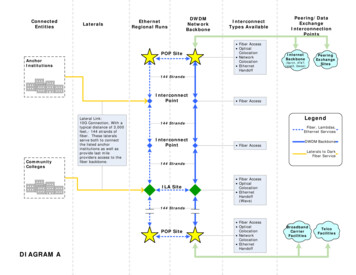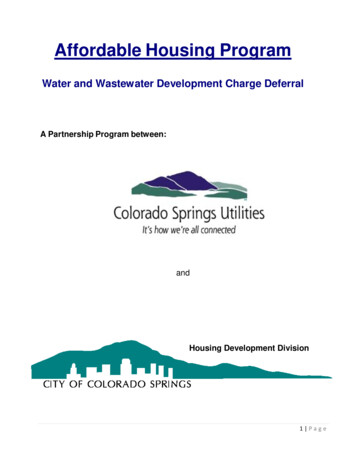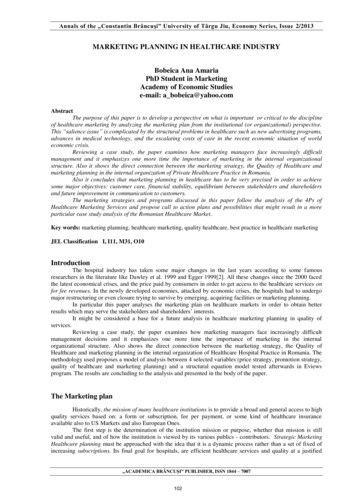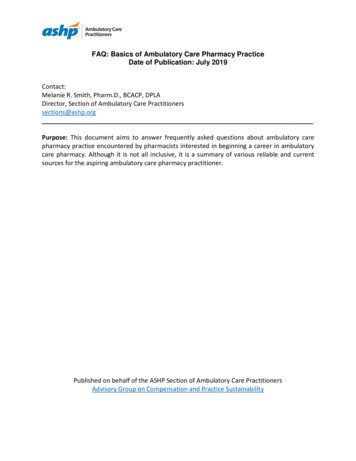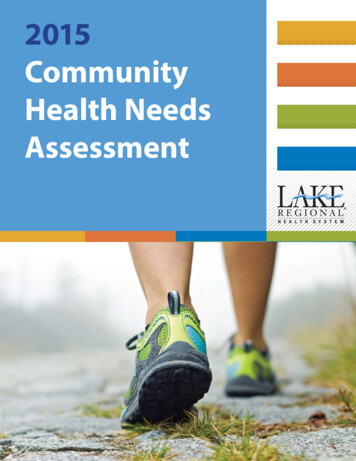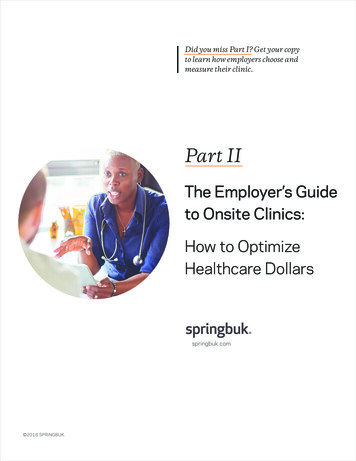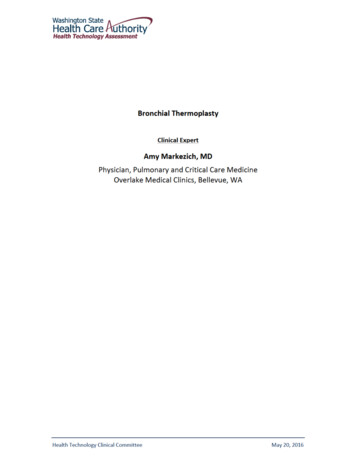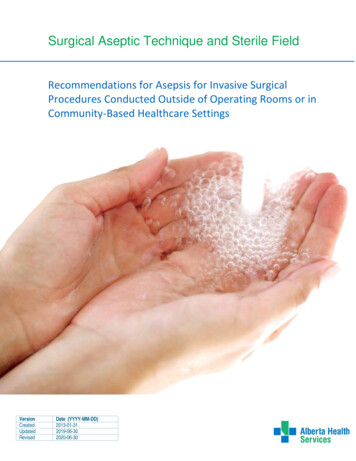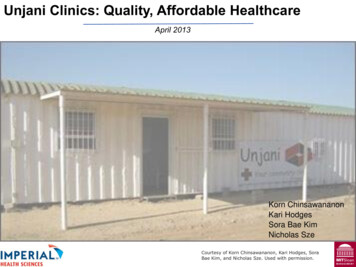
Transcription
Unjani Clinics: Quality, Affordable HealthcareApril 2013Korn ChinsawananonKari HodgesSora Bae KimNicholas SzeCourtesy of Korn Chinsawananon, Kari Hodges, SoraBae Kim, and Nicholas Sze. Used with permission.
AgendaI)Executive SummaryII)Team IntroductionsIII)Project BackgroundIV) Problem StatementV)Summary of On-Site ObservationsVI) RecommendationsI)“Big-Picture” QuestionsII)Recommendations for Existing ClinicsIII)Recommendations for Scaling and Future GrowthVII) Suggested 3-Year MilestonesVIII) ConclusionIX) Appendices-2-
Executive SummaryThe MIT Team spent two weeks in Johannesburg, South Africa, working with Imperial Health Sciences (IHS) to improve themarketing methods and financial sustainability of the Unjani Clinics. Unjani currently has 7 franchised clinics located aroundJohannesburg and Cape Town that are owned and run by licensed nurses. The goal of these clinics is to deliver affordable,quality healthcare solutions to communities of South Africa. Unjani management’s vision is to scale Unjani to over 2500 individual clinics in the next few years.While on the ground, the team visited six of the clinics and conducted over 80 interviews with four main constituency groups:Competitors: information gathered from public clinics, private doctors’ offices and Spazas (local shops)/ pharmacies toassess market size, segmentation, and value proposition.Unjani nurses and staff: MIT team assessed current processes and gathered “on-the-ground” best practices to bestandardized across clinics.Customers: current clients shared insights on Unjani’s value proposition, as well as the decision making process thatlead to utilizing Unjani Clinics’ services.Consumers: Interviewed clinic communities to assess needs/services alignment, health care perceptions andassumptions, and willingness to pay.Lastly, the MIT team observed day-to-day clinic operations and engaged in marketing activities to test for ease ofimplementation and strategy effectiveness.General Recommendations:- Big Picture: Evaluate the objectives and goal of Unjani in the context of Imperial’s overall objectives- Training: Focus future training sessions on actual cases and problems that nurses have faced in their businesses- Pricing: Implement a tiered pricing strategy with a fast-turn, low-priced offering (ie. vaccinations) for a low-price to drivecustomer demand and continue to differentiate prices based on clinic location- Awareness: Continued attention on building awareness in the community and marketing is necessary, as actual awarenessis much lower than expected-3-
AgendaI)Executive SummaryII)Team IntroductionsIII)Project BackgroundIV) Problem StatementV)Summary of On-Site ObservationsVI) RecommendationsI)“Big-Picture” QuestionsII)Recommendations for Existing ClinicsIII)Recommendations for Scaling and Future GrowthVII) Suggested 3-Year MilestonesVIII) ConclusionIX) Appendices-4-
Team IntroductionsKorn ChinsawananonMIT Sloan MBA Candidate – 2014Sora Bae KimMIT Sloan MBA Candidate – 2014Korn is a first year MBA student at MIT Sloan where he isfocusing on competitive strategy and operations management.Korn spent 4 years working as an IT and operations consultantin Thailand, Malaysia, and Philippines in industries ranging fromretail to manufacturing prior to his MBA studies. He holds aComputer Engineering degree from Chulalongkorn University.Sora Bae Kim is a first year MBA student at MIT Sloan. Priorcoming to Sloan she worked as a structural engineer in Londonwith topnotch architects on projects ranging from temporary artinstallations to big development projects in Egypt and the MiddleEast. She speaks multiple languages, enjoys running, andmajored Civil Engineering at Imperial College London.Kari HodgesMIT Sloan MBA Candidate – 2013Nick SzeMIT Sloan MBA Candidate – 2014Kari is a second year MBA student at MIT Sloan where she isfocusing on marketing and business development. Prior toSloan, Kari worked in research and research compliance at NewYork University, and in policy at the Cato Institute. Her researchhas contributed to numerous articles, books, and accoladesincluding the written thanks of Avinash Dixit in his bookLawlessness and Economics. Kari Holds a BA from BrownUniversity.Nick is a first year MBA student at MIT Sloan where he isfocusing on strategy, marketing, and healthcare. Prior to Sloan,Nick worked at Accenture as an IT Consultant in the Healthcareindustry. He worked on the delivery of large systemsimplementations for a health insurance client and a pharmacyclient. Nick holds a B.S. in Industrial Engineering andManagement Sciences (IEMS) as well as a B.A. in Economicsfrom Northwestern University.-5-
AgendaI)Executive SummaryII)Team IntroductionsIII)Project BackgroundIV) Problem StatementV)Summary of On-Site ObservationsVI) RecommendationsI)“Big-Picture” QuestionsII)Recommendations for Existing ClinicsIII)Recommendations for Scaling and Future GrowthVII) Suggested 3-Year MilestonesVIII) ConclusionIX) Appendices-6-
Project Background – Company History Imperial, a Logistics company with market capitalization of approximate R20 billion, has recentlypurchased RTT Health Services for R500 million to be incorporated into their Imperial HealthSciences (IHS) Division In 2010, RTT launched a program to leverage its logistical expertise in the social enterprisesector by creating a clinic-in-a-box CSI initiative named Unjani to: Tackle the primary healthcare shortage among low income population in the country Promote entrepreneurship among the salaried nurses through franchising model Pilot program started in September 2010 with two clinics in Etwatwa and Wattville, has nowgrown to 7 fully functioning clinics. Initial price point was R60 for consultations, and currently charging a price ranging from R100 toR150 (depending on the clinic location) for all treatments and medication provided. IHS’s vision within the next 4 years is to build a sustainable network of 2,500 Unjani clinicsacross the country, including in rural and semi-rural areas, where public health care facilities areoften far away.-7-
Project Background – South African Primary Healthcare System The South African primary healthcare system currently has two primary options:1)Public Clinics – located throughout communities across South Africa, the public clinicshave a reputation for long queues, poor service, and being understaffed. Service is free,as long as people are willing to wait. Medications are prescribed and given on-site, butare often out of stock.2)Private General Practitioners (GPs) – many communities will also have one or more GPs.Typically, only people with Medical Aid (South African form of Health Insurance) orwealthy can afford to go to GPs, where an average visit will cost R250 with medication asan additional cost. GPs have the community reputation of providing excellent service andno waiting.South Africa has a form of health insurance called Medical Aid. It works very similarly to healthinsurance in the US and is typically employer-provided. Most GPs accept Medical Aid. Unjaniclinics currently do not accept Medical Aid but have plans to implement an IT system with thecapability to handle Medical Aid.Map of South Africa removed due to copyright restrictions.-8-
AgendaI)Executive SummaryII)Team IntroductionsIII)Project BackgroundIV) Problem StatementV)Summary of On-Site ObservationsVI) RecommendationsI)“Big-Picture” QuestionsII)Recommendations for Existing ClinicsIII)Recommendations for Scaling and Future GrowthVII) Suggested 3-Year MilestonesVIII) ConclusionIX) Appendices-9-
Problem Statement While the pilot has been moderately successful in its mission to deliver an affordable healthcaresolution, the main challenge is making the franchise model financially and operationallysustainable. The main problems facing the existing clinics are: Lack (and volatility) of patient volume Lack of awareness in the community Lack of standardized nurse selection process Unclear roles and responsibilities between franchiser and franchisees Poor clinic-location choice in communities with very high unemploymentThe goal of scaling from 7 existing clinics to a future vision of 2,500 clinics within the next fewyears presents Unjani with a significant logistical, operational and strategic challenge.- 10 -
AgendaI)Executive SummaryII)Team IntroductionsIII)Project BackgroundIV) Problem StatementV)Summary of On-Site ObservationsVI) RecommendationsI)“Big-Picture” QuestionsII)Recommendations for Existing ClinicsIII)Recommendations for Scaling and Future GrowthVII) Suggested 3-Year MilestonesVIII) ConclusionIX) Appendices- 11 -
Summary of On-Site Observations and InterviewsGeneral ObservationDetails and ExamplesPatients are willing to be mobile(within reason) to access healthcareThere is an abundance of private transportation ranging fromtaxis (only a few rands) and people have high mobility to choosethe clinic they want for healthcare. This was highly visible in thepeople we talked to in both Etwatwa and Villa Lisa.Quality-of-care difference betweenpublic clinics and Unjani clinicsdiffers from location to locationCertain communities had very impressive public clinics (i.e. theVilla Lisa public clinic is very clean and well-run with nosignificant service difference from Unjani clinic), while othercommunities had public clinics that met our initial expectations.Most public clinics did report some problems with medicationstock-outs from time to time.Patients experience significant waittimes at Unjani, sometimes evenmore than at public clinics3 hour patient wait times were observed in both Etwatwa andVilla Lisa Unjani clinics. Wait times at public clinics differs fromlocation to location and by time of day (ie. high wait times inEtwatwa, vs. low wait times in Villa Lisa).Target market mismatchThe target market for Unjani is supposed to be employedpeople with lack of healthcare access. However, theneighborhoods that the clinics are in are full of unemployedpeople where R100 is the equivalent of selling 14 bottles ofwater or 10 haircuts.Lack of community awarenessEven people around the clinic within 500 meters are not awareof the clinic.- 12 -
Summary of On-Site Observations and Interviews (cont.)General ObservationDetails and ExamplesServices offered at Unjani are notwhat the community needs the mostVaccines/immunizations, hypertension, and diabeticmedications are most needed by the community.Clinic is not at operating asefficiently as expected (expectationis 15 minutes per patient onaverage)From the wait time we have observed the average time perpatient is more likely to be closer to 30 minutes than 15. Thisreduces the total capacity by half.Most nurses have intuitive businesssense, even if they may not havetraditional business trainingNurses know the their communities and their business well.They adjust treatment prices based on the observed willingnessto pay and location.There is strong competition forselling OTC medicines in thespazas.Spazas in general sell well-diversified medicine (grandpapowder, flu medicine, and painkillers) at lower or equal to pricepoints to Unjani.Community unemployment andwillingness to pay is much lowerthan expected for most cliniclocationsExcept for the Unjani Clinics in Kwaggafontein and Soweto,most of the clinics were located in communities with extremelyhigh unemployment and very low willingness to pay. Not onlyare people in these communities willing to wait in long publicqueues for healthcare, but they also survive on grants of R280per month, so paying R150 is out of the question.- 13 -
Publics Clinics are not always overcrowded and can be quite nicePhotograph of public clinic removed due to copyright restrictions.- 14 -
Wait times at the Unjani clinic can exceed 3 hours- 15 -
There is a great deal of competition for OTC drugs at local Spazas- 16 -
AgendaI)Executive SummaryII)Team IntroductionsIII)Project BackgroundIV) Problem StatementV)Summary of On-Site ObservationsVI) RecommendationsI)“Big-Picture” QuestionsII)Recommendations for Existing ClinicsIII)Recommendations for Scaling and Future GrowthVII) Suggested 3-Year MilestonesVIII) ConclusionIX) Appendices- 17 -
“Big-Picture” RecommendationsBased on our conversations and observations, we are not clear on the true objective of theUnjani Clinics and how this initiative supports Imperial's strategy as a whole.We recommend for management to:1) Evaluate the true rationale for Unjani in the context of Imperial’s overall strategy2) Evaluate if there are more effective ways for Imperial to leverage its core competencies tomeet its overall objectivesImperial Strategyand ObjectivesUnjani Strategyand Objectives- 18 -
“Big-Picture” Questions For DiscussionSuggested Questions for Discussion:1) What is the true goal of the Unjani clinics and how does it fit within the overall goals ofImperial? What does Imperial gain from having the Unjani Clinics?2) If Unjani is a CSI initiative, why doesn't Unjani get more limelight/publicity and funding?Why is it not a more important initiative for Imperial?3) Why is Unjani structuring the financials so that it takes a significant net loss on everyclinic it opens? Why is Imperial willing to take this loss? Is this loss sustainable for the2500-clinic end vision?Additional Clarifying Questions:1) If the true objective is for Imperial to be able to have Market Access to the BOP todistribute for partner pharmaceutical companies, why not consider trying to becomeexclusive suppliers for the public clinics that already exist?2) If Imperial wants to deliver an affordable healthcare option to the market segment justabove the BOP, should income data play a role in determining clinic location? Incommunities with over 80% unemployment and very low willingness-to-pay, should clinicsexist?3) If the true objective is to scale to 2500 clinics within the next few years, why is scalingquickly critical for success? How does the timing help meet your objectives? Should thepilot scenarios play out first to ensure the clinics can be sustainable before scaling?- 19 -
AgendaI)Executive SummaryII)Team IntroductionsIII)Project BackgroundIV) Problem StatementV)Summary of On-Site ObservationsVI) RecommendationsI)“Big-Picture” QuestionsII)Recommendations for Existing ClinicsIII)Recommendations for Scaling and Future GrowthVII) Suggested 3-Year MilestonesVIII) ConclusionIX) Appendices- 20 -
Recommendations for Existing ClinicsOur recommendations can be classified into 4 major areas:Nurse Skills & TrainingServices & PricingAwareness & MarketingFuture training sessionsshould focus on actual casesand problems that nurseshave faced in their businessesClinics should vary theservices offered as well as thecorresponding prices basedon each community’swillingness to pay andavailability/accessibility ofcompetitionAwareness in the communityis actually much lowerexpectations – a focus onadditional marketing andawareness is necessary todrive volume.Set expectations andresponsibilities betweenNurses and Management Partner with Public Clinicsto “share the burden” Nurses should assumeownership andresponsibility for clinic dayto-day operations withoutrequiring input ofmanagement Casebook More relevant, interactive,and applicable Use extensive trainingapproach and lessons fromWarehouse-in-a-Box totrain nurses Offer a fast-turn, highrevenue service (ie.vaccinations) at a lowerprice point, R50.– Drives awareness– Additional revenue-stream SMS or call to remindpatients about adhering tofollow-up consultations Market through TownMeetings and events If nurses cannot handle theresponsibility of Marketingin addition to clinical duties,consider hiring a centralmarketing person tooversee these tasks- 21 -Management Dynamics Management should not beoverseeing daily clinic tasks The roles andresponsibilities betweenmanagement and thenurses should be moreclearly defined upfront
Overall Pricing Strategy and Recommendations Our initial hypothesis was to charge a uniform set of prices across all clinics in order tostandardize prices to allow for scalability. However, after visiting the clinics and communities, we have concluded each clinic shouldcontinue to charge different prices ranging from R100-R150 based on: Community unemployment and willingness to pay Availability and service of local public clinics Availability of private GPs Location and proximity to town centers, shopping centers, etc.In addition, we continue to believe the greatest obstacle to breaking even is to achieveconsistent patient volumes. To address this, we recommend: Instilling a focus on patient throughput and operational efficiency. In our observations wenoticed some Unjani clinics with 3 hour wait times and patients being treated for over anhour. Implementing a fast-turn, low-price offering such as vaccinations to drive awareness.- 22 -
Pricing Recommendations – Additional Revenue Stream Analysis To increase awareness and drive demand, we recommend offering a fast-turn, low-pricedoffering (ie. vaccinations) for a low-price (R50-R75) to drive customer demand and buildawareness for other clinic services. Ideally, a vaccination day should be offered on a Saturdaywith scheduled appointments to maximize throughput and to reduce impact on normal clinicbusiness Consider leveraging the strong supply chain capabilities of Imperial to become the drugsuppliers for public clinics, which frequently face stock-out issues We also considered the following revenue streams: Chronic Prescription Dispensing – ruled out because nurses cannot dispense aprescription they did not prescribe Reading Glasses – currently sourced from Visionspring and under pilot program Sonar – ruled out because of low demand and breakeven on a sonar machine would takeover 2 years OTC Medications (ie. Panadol) – Lots of competition from spazas and pharmacies Nappies/Diapers – Price competition from spazas- 23 -
Suggested Delineation of ResponsibilitiesWe recommend clearly defining the responsibilities of management and nursesIHS Management ResponsibilitiesUnjani Nurse Business OwnerResponsibilitiesAnalysis of clinic reportsProviding accurate and timely financial, patientvolume and stock reports to managementConfirming stock ordersMarketing in local communityBusiness development – expansion of new clinics,growth strategy, etc.Addressing problems that may arise for theirclinic (plumbing issues, marketing issues,community relationship issues)Planning ongoing training efforts, assessingeffectiveness of training, determining future trainingneedsOverall management and running of clinicAddressing poor-performing clinicsHiring and firing of clinic employeesHiring and managing of middle management (fieldmanagers)Landscaping and clinic aestheticsSchedule and perform quarterly reviews with nursesPreparing analysis of past quarter performance,as well as 1-month, 3-month, and 1-year goalsfor quarterly review with management- 24 -
AgendaI)Executive SummaryII)Team IntroductionsIII)Project BackgroundIV) Problem StatementV)Summary of On-Site ObservationsVI) RecommendationsI)“Big-Picture” QuestionsII)Recommendations for Existing ClinicsIII)Recommendations for Scaling and Future GrowthVII) Suggested 3-Year MilestonesVIII) ConclusionIX) Appendices- 25 -
Recommendations for Scaling and Future GrowthCurrent ApproachSuggested ApproachLocation choice primarily based on nursepreference and community surveysCareful analysis of clinic location choice basedon following factors In-depth analysis of community employment andwillingness-to-payLocation Choice Availability and accessibility of competition (ie.public clinics and other private clinics)Future Vision is to scale to 2500 clinics overfive year periodUnderstand how to make existing modelfinancially sustainable and successful beforescaling Allow pilot to complete to see if clinics can besuccessful without supporting working capitalTiming Restructure nurse contracts to be financiallysustainable for IHS in long-term or shut downinitiativeMajor marketing events are planned only whenclinic is opened (ie. Diabetes testing for taxidrivers)Building AwarenessCommunity awareness events are a smallportion of overall Marketing efforts needed Partner with local public clinics to obtain referralsand market at local public clinics Plan ongoing community awareness eventsbased on focus-topic of the month (ie. TB, HIV)- 26 -
AgendaI)Executive SummaryII)Team IntroductionsIII)Project BackgroundIV) Problem StatementV)Summary of On-Site ObservationsVI) RecommendationsI)“Big-Picture” QuestionsII)Recommendations for Existing ClinicsIII)Recommendations for Scaling and Future GrowthVII) Suggested 3-Year MilestonesVIII) ConclusionIX) Appendices- 27 -
Unjani Clinic – Pre-Clinic Launch Milestones and GoalsPre-ClinicLaunch1) Nurse ChoiceDevelop a more rigorous process for selection ofnurses based on the following factors: Business knowledge Problem solving ability Outspokenness, personality and sociability Patient Presence Resistance to adversity Connection to community Target clinical nursesSuggestion: Have a successful Unjani clinicnurse interview potential nurses4) Establish clear relationship between Nurseand Management Clearly delineate responsibilities of nursesand management Develop layer of middle-management(Mabatu?) to oversee daily operations,finances and nurse oversightYear 12) Location ChoiceDevelop a more rigorous process for selectingclinic locations based on following criteria: Availability and quality of Public Clinics Income level of community Employment status of community members Availability of Private GPs Proximity to community5) Community AwarenessBuild community awareness and hype for clinicBEFORE the clinic has been launched Build relationship with Counselor Build relationships with Ministry of Healthfor vaccinations Build relationship with Public Clinicmanagement for cross-referrals and stockouts Build awareness at Town Halls, churches,schools Plan large marketing events to buildawareness- 28 -Year 2 &Onwards3) Training and MaterialsDevelop an extensive, comprehensive multipweek nurse training program as well as providea “welcome packet” of useful information Leverage best practices from Warehousein-a-box training program Training should include how to hire a goodassistant Training materials should include acasebook of Unjani-specific businessproblems and how they were resolved Welcome Packet includes contactinformation for IT, Facilities, Maintenance Welcome Packet includes marketing plantemplates Welcome Packet clearly designates rolesand responsibilities of Nurse-owner andManagement
Unjani Clinic – Year 1 Milestones and GoalsPre-ClinicLaunch1) MarketingIn the first year of operations, it is critical todevelop awareness of the clinic in the communityand build patient volume Develop a marketing calendar of requiredevents (ie. HIV Awareness program, etc.) Share success of individual clinic’s marketinginitiatives with other clinics4) Community RelationshipsIt is important to community to leveragecommunity relationships to build awareness forthe clinic in the first year. Co-Plan Awareness Days with local PublicClinics 1x / Month Develop relationships with management atPublic Clinics and distribute pamphlets Cross-refer patients with public clinics Establish stock-out plan with public clinics Establish vaccination sourcing with Ministry ofHealthYear 12) PricingCreate a two-tiered price structure for eachclinic based on community economic statusand cost Price Point 1: R50-75 for high-volume, quickturnaround, low-cost new services such asImmunizations, Eye Test, Birth Controlshots Price Point 2: R100-150 (dependent onclinic location) for consultation and meds Develop a structured and data-driven pricereview process based on historic clinicsales5) Quarterly ReviewEstablish a quarterly review process with eachclinic to reflect on the past quarter’sperformance and establish an improvementplan for the future Nurse-owner is expected to be prepared todiscuss past quarter performance (patientvolume trends, financials, what went welland poorly) Management is expected to help the nursedraft a plan for how to improve their specificclinic in the upcoming quarter- 29 -Year 2 &Onwards3) TrainingIt is essential to continue to train the nursesthrough off-site, action-oriented and targetedtraining programs that teach specific strategiesapplicable in their businesses Provide a “casebook” of real businessproblems and present group-based trainingwhere nurses can discuss solutions andfinally the successful implemented practice Provide on-site training at clinics in IT,Accounting and Finance where someonecomes to the clinics bi-weekly and reviewseach clinics’ practices and teaches bestpractices6) End of Year Clinic Performance ReviewAt the end of year 1, Management shouldestablish a formal review process to reviewclinic performance in the following areas: Patient Volume and Financials Quality of Care Nurse Performance Improvement opportunities
Unjani Clinic – Year 2 & Onward Milestones and GoalsPre-ClinicLaunch1)MarketingAssessment of first year strategy effectivenessis necessary before pursuing new strategies.Proven best practices should be integrated intotraining curriculum. Introduce follow-up bundles/ appointmentsbased on patient data Design specific treatment days Partner with non-health organizations(fluoride rinse at school) Expand marketing/ services to otherneighborhoods. Create specific program packages such asmaternity and specialty higher price services. Expand events with public clinic to increasereachNote: Repeat all year one tactics for marketingand training.Year 12) PricingIntegrating pricing complexities createopportunities to maximize value to customersand capture greatest market share. Assess and Adjust prices to fit customersand costs. Price product bundles to support volumeincreases.4) Management Conduct quarterly reviews Facilitate group sessions Develop and execute training of FieldAgents Set strategic direction of Unjani brand andcommunicate goals to nurses- 30 -Year 2 &Onwards3) Operational Electronic Medical Records Eliminate underutilized services– reviseproduct mix to suit community needs Home/ site visits to create high volumeopportunities Call/ text reminders for chronic diseaseappointments5) Training Continue “casebook” group session todiscuss new challenges and possiblesolutions as a group Continuous data entry skills development Action-oriented training updates inmarketing and service.
AgendaI)Executive SummaryII)Team IntroductionsIII)Project BackgroundIV) Problem StatementV)Summary of On-Site ObservationsVI) RecommendationsI)“Big-Picture” QuestionsII)Recommendations for Existing ClinicsIII)Recommendations for Scaling and Future GrowthVII) Suggested 3-Year MilestonesVIII) ConclusionIX) Appendices- 31 -
ConclusionWhile the pilot has been moderately successful in its mission to deliver an affordable healthcaresolution, the main challenge is making the franchise model financially and operationallysustainable.To this end, our team has the following recommendations:- Big Picture: Evaluate the objectives and goal of Unjani in the context of Imperial’s overallobjectives- Training: Focus future training sessions on actual cases and problems that nurses have faced intheir businesses- Pricing: Implement a tiered pricing strategy with a fast-turn, low-priced offering (ie. vaccinations)for a low-price to drive customer demand and awareness, and continue to differentiate pricesbased on clinic location- Awareness: Continued attention on building awareness in the community and marketing isnecessary, as actual awareness is much lower than expected- 32 -
AgendaI)Executive SummaryII)Team IntroductionsIII)Project BackgroundIV) Problem StatementV)Summary of On-Site ObservationsVI) RecommendationsI)“Big-Picture” QuestionsII)Recommendations for Existing ClinicsIII)Recommendations for Scaling and Future GrowthVII) Suggested 3-Year MilestonesVIII) ConclusionIX) Appendices- 33 -
Appendix A: Clinic Specific Observations and Field NotesWe have compiled a presentation of our “Field Journal” – a summary of site visits to each clinic, thequestions we asked to patients, as well as their responses. This detailed account of ourobservations will be invaluable data to support our recommendations.- 34 -
Appendix B: Recommended Follow-up Studies and Projects1)Further evaluation and discussion of “Big-Picture” questions2)Casebook compilation of business cases and business problems that Unjani nurses have facedto be used in future training sessions3)Field testing of recommended Pricing Strategy (ie. charging a low price for a quick-turn servicelike vaccinations) to drive volume and clinic awareness4)Further evaluation of operational efficiency within clinics (ie. testing effectiveness ofimplementing a check-in process, strict adherence to timing guidelines per patient)5)Nurse training and change management initiatives for implementation of new IT system toimprove patient records and check-in process- 35 -
Appendix C: Takeaways from Causal Loop Diagram of Unjani Clinics1)2)3)Price is only one of the manyfactors that affect the decision forpeople to come to Unjani ClinicsPatient Volume growth isdependent on word of mouthadvertising and the awareness ofthe clinic in the communityManagement should beconcerned about the possibilitythat increased patient volume willlead to longer wait times and poorserviceClinic Marketing R Public Awarenessof ClinicAvailability ofPublic ClinicsClinic RevenuesClinic Growth inCommunity - Clinic Prices- No. Patientswho come to- Unjani ClinicAvailability ofPrivate Clinics Proximity of UnjaniClinic to communityTreatment RateNo. TreatedPatients Quality of CareProvidedClinic Wait TimesNurse Personality andSocialable-nessB Patient SatisfactionDecreasingQuality of Care Word of Mo
MIT Sloan MBA Candidate - 2014 . Sora Bae Kim. MIT Sloan MBA Candidate - 2014 . Kari is a second year MBA student at MIT Sloan where she is focusing on marketing and business development. Prior to Sloan, Kari worked in research and research compliance at New York University, and in policy at the Cato Institute. Her research
